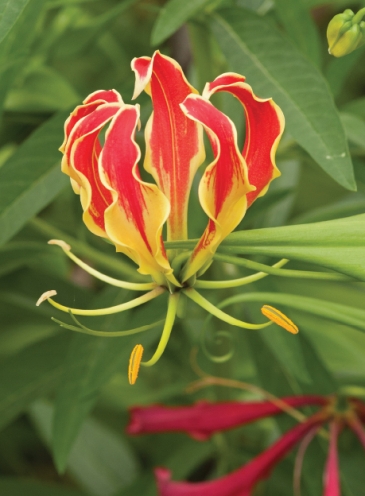Gloriosa superba ‘Rothchildiana’ — now there’s a mouthful! When it comes to botanical names, this is about as pompous as it gets. But this plant, commonly called the gloriosa lily, has the visual goods to back up such an ostentatious tag.
Gloriosa superba is a herbaceous perennial vine, making it a rather unusual member of the lily family, and ‘Rothchildiana’ is one of its more popular cultivars.
Grown from a tuber planted in late spring, it rapidly matures in the simmer of the summer heat. Aided by slender, 3-inch-long leaves that taper to coiling, grasping tendrils, the gloriosa lily can climb upward to 6 feet or more in height and about 3 feet wide.
And when this diva-in-the-dirt blooms, ‘Rothchildiana’ becomes a real showstopper with its flowers’ slender, wavy, 3-inch petals sassily showing off streaks of bright crimson edged in sharp yellow, defying passersby not to notice.
To add even more interest to such sultry colors, its reflexed petals look like they are being fluttered backward by a breeze.
Obviously, the more blooms a gloriosa lily produces, the greater the glory. This is best done by planting it in well-drained, organically rich soil in a sunny location that fades into the shade on hot summer afternoons. Including regular feedings of a diluted liquid fertilizer will also help increase its flower power.
This vine’s stems are a bit weak, so a fence or trellis is necessary for support. As an interesting alternative, it can be planted next to shrubs with open habits, such as sweet shrub, red-twig dogwood or butterfly bush, and allowed to wander into, through and out of the branches.
Gloriosa lily is usually not bothered by deer and rarely pounced upon by insects or diseases. It can, however, have problems with another garden constant: winter.
This fancy vine originates from the African tropics, so cold hardiness can be an issue. But there are three ways to deal with winter.
First, simply leave the tuber outside undisturbed in the ground. Gloriosa lily is rated as hardy up to Zone 8, but our Zone 7 sure seems like it has been getting warmer lately. So, if the tuber is planted in a sunny, protected spot and insulated from the cold with fresh mulch, it stands a chance of making it through typical winters in this region.
Growing this lily-on-a-vine in a large container is another option, with the pot and dormant plant being brought inside to a dry, cool (around 60 degrees) place before freezing temperatures shut down the growing season.
Alternately, garden-grown tubers can be dug up (Do it carefully — they break easily!) in the fall and tucked away indoors until next spring.
L.A. Jackson is the former editor of Carolina Gardener Magazine. Want to ask L.A. a question about your garden? Contact him by email at lajackson1@gmail.com.
Timely Tip
Looking for expert tomato growing advice? You’re in luck.
Just in time for this year’s summer growing season, North Carolina’s “Tomato Man,” Craig LeHoullier, who has collected and tested more than 1,200 varieties in his 30-plus years’ pursuit of the best ’maters, shares his wisdom with fellow gardeners in a newly released book, Epic Tomatoes (Story Publications).
LeHoullier, a Triangle resident, provides generous helpings of planting, cultivation and seed-saving tips as well as his top ten list of what he considers to be the tastiest tomatoes.
To Do in the Garden: May
- If your house cactus, African violet or amaryllis has become slightly root-bound in its container, don’t repot — the cramped quarters will encourage blooming.
- Placing a rain gauge in the garden can add more precision to your decisions to water plants this spring and summer.
- Concerned about sowing pinhead-sized seeds too thickly? Mix them with fine sand, pour into an unused salt shaker, and sprinkle the seeds into their proper place in the garden.
- Annuals such as zinnias, salvias and petunias can become long and lanky, but pinching the plant tips back when they are about 6 to 8 inches tall will encourage bushier growth that produces more flowers.
- Water is critical for garden-grown onions and cucumbers. If not watered regularly, onions won’t mature to their proper, plump size, and cukes will develop a bitter taste. Adding mulch will also help retain ground moisture.
- When planting tomatoes in the spring, take advantage of the warm soil close to the surface (which induces strong root growth) by setting the plantlets parallel to the ground in well-worked trenches rather than in deep holes, and burying all but the upper 4 inches of each plant.
- If spring cleaning has you throwing out an old carpet, put it to use in the garden by cutting the rug into strips wide enough to fit between rows or beds. In order to blend in better, this free, effective weed block for paths should be turned over (the backing tends to be a neutral color) and then covered with gravel, flagstone or wood chips.
- Nesting activity will still be going on this month, so while filling the bird feeder regularly, also include some 3-inch-long pieces of string or yarn to help with nest-building.







